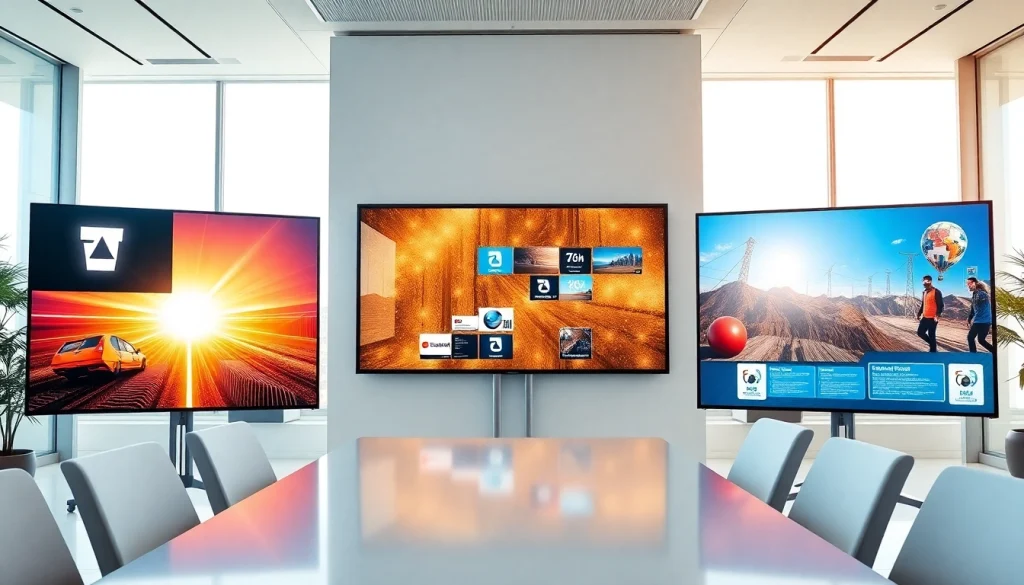
Understanding Multi-screen Digital Signage Management
In today’s fast-paced digital environment, businesses and organizations are increasingly turning to Multi-screen digital signage management as a tool to enhance communication, marketing strategies, and customer engagement. Multi-screen digital signage refers to the deployment of video walls or multiple displays to convey cohesive messages across various platforms and locations. As a result, it plays a pivotal role in ensuring that information is not just disseminated but delivered in a visually appealing and engaging manner.
What is Multi-screen Digital Signage?
Multi-screen digital signage involves the use of multiple screens to display dynamic and engaging content, such as images, videos, animations, and interactive elements. This technology allows companies to present their messages innovatively, blending visuals that captivate audiences and maintain their attention. The integration of various types of digital displays, ranging from LCD monitors to projection systems, enables businesses to create immersive environments that foster deeper connections with their customers.
Key Benefits of Multi-screen Digital Signage Management
The management of multi-screen digital signage offers numerous advantages for organizations seeking to improve their communication strategies:
- Increased Engagement: With visually captivating content displayed across multiple screens, audience engagement levels rise significantly. Eye-catching visuals draw attention and can help convey messages more effectively.
- Versatile Content Delivery: Organizations can tailor content to specific audiences by utilizing multiple screens. Whether it’s targeted advertising, wayfinding, or informational displays, the flexibility of multi-screen setups is invaluable.
- Brand Consistency: Multi-screen digital signage ensures a consistent brand message across diverse platforms, enhancing brand identity and recognition.
- Efficiency in Management: Centralized content management systems permit easy updates and monitoring, saving time and effort while ensuring accuracy.
- Real-time Updates: The ability to update content in real time enables businesses to respond promptly to changing situations or promotional opportunities.
Common Use Cases for Multi-screen Digital Signage
Organizations across various industries have embraced multi-screen digital signage to fulfill diverse functions:
- Retail: Retailers employ multiple screens for advertising promotions, displaying product information, and enhancing the overall customer experience.
- Corporate: Businesses utilize digital signage for internal communication, displaying announcements, meeting schedules, and employee recognition.
- Transportation: Airports and transit stations use multi-screen installations to provide travelers with real-time updates on flights, schedules, and wayfinding information.
- Education: Schools and universities create engaging learning environments by using multi-screen setups in classrooms or public spaces for announcements, event promotion, and educational content.
- Healthcare: Hospitals and clinics deploy digital signage to keep patients informed about wait times, services, and health tips, enhancing the overall patient experience.
Essential Components of Effective Management
Hardware Requirements for Multi-screen Setups
Setting up a multi-screen digital signage network necessitates specific hardware components that ensure seamless operation. Key elements include:
- Displays: The choice of screens is crucial. Organizations must consider factors such as size, resolution, and technology (LCD, LED, or OLED) to choose the right displays that best meet their requirements.
- Media Players: Each screen may require a media player capable of decoding and rendering high-quality content. Multi-display setups might rely on powerful media players that can manage multiple outputs simultaneously.
- Mounting and Structuring: Proper mounting solutions and physical structures are essential to ensure that screens are arranged optimally for visibility and accessibility.
- Cabling and Network Infrastructure: The setup must include robust cabling and a reliable network infrastructure to support communication between displays and content management systems.
- Power Management: Implementing an effective power management solution prevents disruptions and enhances the lifespan of the screens.
Software Solutions for Streamlined Management
Equally important is the software that allows for the centralized management of content across the multiple screens. This includes:
- Content Management Systems (CMS): A robust CMS provides tools for designing, scheduling, and distributing content to various screens, significantly simplifying management tasks.
- Analytics Software: Utilizing analytics software helps organizations measure engagement levels and audience reactions, offering insights into the effectiveness of their digital signage strategies.
- Integration with Other Systems: The best software solutions will allow integration with other platforms such as social media, weather updates, and local news to enhance the relevance and dynamism of displayed content.
- Template Creators: These tools enable users to create customized templates effortlessly, allowing for consistent branding and design.
Content Strategies for Multi-screen Experiences
Effective content strategies are fundamental to the success of multi-screen digital signage. Consider the following approaches:
- Storytelling: Crafting stories through a combination of visuals and text can create a more engaging experience for viewers. Multi-screen setups can enhance storytelling through transitions and synchronized displays.
- Dynamic Content: Refreshing content regularly keeps the audience’s attention. Organizations should take advantage of seasonal promotions, new products, and time-sensitive messages.
- Interactivity: Incorporating interactive content encourages viewer participation and can significantly enhance customer engagement.
- Audience Targeting: Understand the demographics of the audience viewing the displays to curate tailored content that resonates well with them.
Best Practices for Implementation
Planning Your Multi-screen Digital Signage Network
Implementation begins with thorough planning. Organizations should assess their objectives, understand the target audience, and determine the best locations for installation. Effective planning should also include:
- Site Surveys: Conducting comprehensive surveys helps identify the best locations for screens, factoring in visibility, interaction opportunities, and foot traffic.
- Budget Consideration: Establishing a clear budget from the outset helps in selecting the right hardware and software solutions without overspending.
- Content Roadmap: Developing a content roadmap ensures that messages remain relevant and aligned with the organization’s goals over time.
Installation and Configuration Tips
Once the planning stage is complete, the installation phase is critical. Useful tips include:
- Professional Installation: Hiring professionals who specialize in digital signage can prevent technical issues and streamline the installation process.
- Screen Calibration: Ensuring that all screens are properly calibrated for brightness, color, and resolution guarantees a cohesive viewing experience.
- Testing Connectivity: Before fully deploying the system, testing connections between devices can help identify and resolve potential issues.
Testing and Troubleshooting Multi-screen Systems
Successful implementation includes ongoing testing and troubleshooting where necessary. Key aspects to monitor include:
- Regular Maintenance Checks: Schedules for routine maintenance ensure devices function optimally over time.
- Performance Monitoring: Utilizing software solutions to track performance can identify issues quickly and reduce downtime.
- Customer Feedback: Collecting feedback from users can help reveal pain points and areas for improvement, making it easier to refine the overall experience.
Measuring Success and ROI
Key Performance Indicators for Multi-screen Deployment
Assessing the success of a multi-screen digital signage initiative involves tracking specific metrics, including:
- Engagement Rates: Analyzing viewer engagement through various methods, such as foot traffic analysis or interactions with displays, provides valuable insights.
- Conversion Rates: Evaluating how many viewers take action after viewing signage can quantify the effectiveness of marketing messages.
- Content Analytics: Determine which content resonates most with audiences by measuring the performance of different types of media.
Tools and Techniques for Performance Analysis
Using the right tools can greatly enhance data analysis, leading to informed decisions. Techniques include:
- Analytics Software: Investing in robust analytics tools allows organizations to gather detailed insights into viewer behavior and campaign performance.
- Surveys and Feedback Loops: Engaging audiences with surveys post-interaction can provide qualitative insights that numbers alone may not reveal.
Adjusting Strategies Based on Data Insights
It is vital for organizations to remain agile and responsive based on data analysis. This could involve:
- Content Evolution: Regularly updating content strategies based on analytic findings can keep messaging fresh and relevant.
- Targeting Adjustments: Modifying targeting strategies to align more closely with the audience’s interests can lead to improved engagement.
The Future of Multi-screen Digital Signage
Trends Shaping the Digital Signage Landscape
The future of multi-screen digital signage is promising, characterized by key trends such as:
- Increased Interactivity: Technology advancements are enabling more interactive digital signage experiences, allowing users to engage more fully with content.
- Augmented Reality (AR) Integration: AR has the potential to create immersive experiences by blending digital content with the real world, enhancing viewer engagement.
- AI and Machine Learning: Leveraging artificial intelligence for personalized content delivery based on viewer data is becoming an industry standard.
Emerging Technologies in Multi-screen Management
Technological advances will continue to reshape the digital signage landscape, including:
- Cloud-based Solutions: Adopting cloud technology for content management offers flexibility, scalability, and reduced infrastructure costs.
- High-Definition Displays: Continuous improvements in display technology will enhance the visual impact of multi-screen setups.
Preparing for the Evolution of Digital Signage
Organizations looking to stay ahead in the multi-screen digital signage realm should consider the following:
- Investing in Training: Ensuring staff are well-trained in the latest technologies and practices will optimize system effectiveness.
- Adopting a Long-term Vision: Maintaining a forward-looking approach helps organizations adapt to rapid technological advancements and industry trends.






